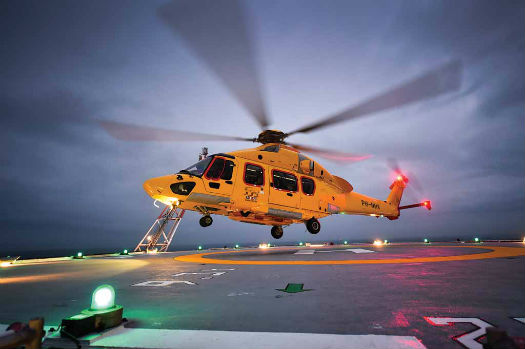
The Airbus Helicopters EC175 entered revenue service in December 2014 with the NHV Group on the Netherlands continental shelf, operating from Den Helder Airport on the North Sea coast. NHV Group Photo
Almost exactly 50 years ago, the first commercial helicopters began flying offshore workers to exploration platforms drilling for hydrocarbons beneath the inhospitable and frigid North Sea.
The discovery of the offshore oil and gas fields on the European continental shelf would go on to transform the economies of Norway, the United Kingdom, the Netherlands, and Denmark — and the North Sea oil-and-gas industry’s influence on the world of helicopter transportation would be similarly dramatic, driving innovation among both operators and manufacturers.
Today, the region is the domain of the world’s largest fleet of heavy instrument flight rules (IFR) helicopters, flying in some of the toughest weather conditions to remote platforms high above stormy seas. The total North Sea operating fleet carries almost two million passengers a year from 16 bases located in the United Kingdom (7), Netherlands (1), Denmark (1) and Norway (7).
As such, it provides a very important source of revenue for three of the world’s largest helicopter consortiums — Bristow Group, CHC Group and Babcock Mission Critical Services (parent company of Bond Offshore of the U.K. and Norsk Helikopterservice of Norway). In fiscal year 2014, European business accounted for 58 percent of CHC Group’s annual revenues and 44 percent of the Bristow Group’s operating revenue.

Bristow Helicopter’s European business unit operates 68 heavy helicopters from offshore bases in the UK and Norway, with the Airbus Helicopters EC225 (pictured) and Sikorsky S-92 the mainstays of its fleet. Heath Moffatt photo
While the North Sea is now a mature market and oil production is dropping, the size of the helicopter fleet supplying it has actually increased, as the remaining reserves are generally spread over many smaller fields rather than concentrated in a few large ones.
In recent times, CHC, Bristow, Bond and NHV have also diversified their offshore businesses by winning significant long-term search and rescue contracts for oil companies and government customers, which leverage the operators’ offshore expertise as well as providing them with a new revenue stream.
In the southern North Sea, four smaller offshore operators are also active: Bel Air Aviation A/S of Denmark, and three companies — NHV of Belgium, Blueway Offshore Norge AS of Norway, and DanCopter AS of Denmark — now owned by the NHV Group.
Regional Development
The North Sea — a shallow northeastern arm of the Atlantic Ocean — covers an area of about 290,000 square miles (750,000 square kilometers). The waters have long been important to fishing and maritime trade, but even until the late 1950s, few believed that it could also be a source of energy. This changed when the super-giant Groningen gas fields were discovered beneath the northern Netherlands in 1959, begging the question: Was there oil and gas beneath the North Sea?
The first exploration rigs began drilling off the coast of Germany in 1963, with the Netherlands, the United Kingdom, Denmark and Norway following suit shortly afterwards. BP discovered the first commercial North Sea gas field at West Sole in U.K. waters in 1965, and DUC Consortium discovered the first oil field off Denmark’s coast in 1966, but 200 dry holes were drilled before oil was discovered off Norway (in 1969) and the U.K.(in 1970).
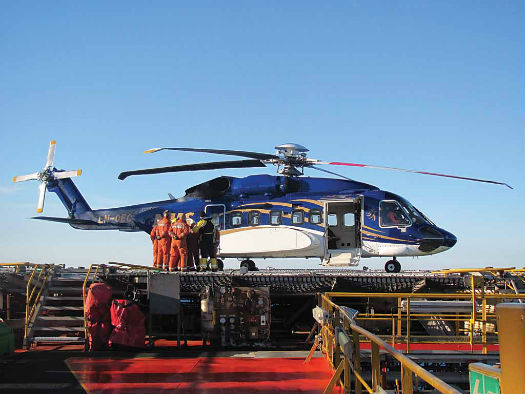
Norsk Helikopterservice (NHS) of Stavanger, Norway, introduced its first S-92s in early 2013. NHS and sister company Bond Offshore Helicopters in the U.K. are both subsidiaries of Babcock Mission Critical Services. Norsk Helikopter Service
Discoveries increased exponentially in the 1970s and 1980s, and new fields were developed throughout the continental shelf. Norway’s largest oil producing fields (and some of the most important helicopter destinations) include: Ekofisk, Snorre, Valhall, Heidrun, Eldfisk, Grane, Oseberg, Åsgard, Alvheim, and Oseberg Sør. The enormous Johan Sverdrup oil field, discovered in 2010, should provide a significant amount of work for years to come.
U.K. oil-and-gas production peaked in the late-1990s, and has declined steadily over the past several years, according to the U.S. Energy Information Administration. The biggest U.K. oil fields and helicopter destinations included Nexen’s super-giant Buzzard oil field, Forties, Captain, Foinaven, Alba, Nelson, Franklin, Machar, Telford and Ninian.
As of January 2015, there were 173 active rigs drilling (according to RigZone), making the North Sea the world’s most active offshore drilling region, with drilling activity well ahead of the Gulf of Mexico (100 active rigs), Brazil (69 rigs) and West Africa (65 rigs).
The North Sea also contains about 400 fixed platforms equipped with helidecks, including 228 on the U.K. Continental Shelf (UKCS), 100 on the Norwegian Continental Shelf (NCS) and an estimated 50 off the Netherlands and Denmark.
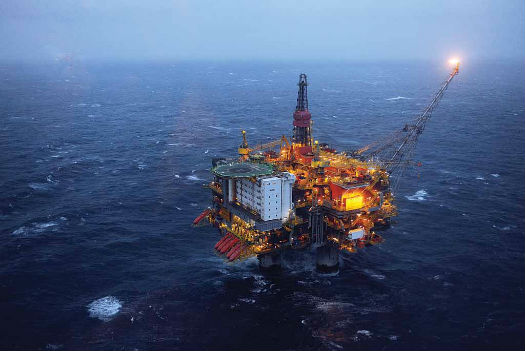
The Statfjord A platform is one of four very large production platforms located on the largest oilfield in the Norwegian Continental Shelf (NCS). A CHC EC225 all-weather search and rescue (SAR) helicopter was introduced on the Statfjord B platform in June 2009. Harald Pettersen Photo
North Sea Air Logistics
There are about 220 medium and heavy helicopters working over the North Sea and adjacent waters, providing direct employment to about 2,500 people. In 2012, the UK helicopter fleet carried over a million passengers. During the same period, the Norwegian helicopter fleet flew approximately 850,000 passengers and the Netherlands and Denmark accounted for more than 150,000 passengers. And, in addition to transport, the North Sea fleet also performs a crucial search-and rescue (SAR) service for oil-and-gas companies and national governments in the region.
The fleet includes more than 150 heavy helicopters (Airbus Helicopters AS332 L/L1/L2 Super Pumas and EC225s, and Sikorsky S-92s), and about 70 medium aircraft (including the Airbus Helicopters AS365 N3 and EC155 B1, Sikorsky S-76C++, and the AgustaWestland AW139). In 2014, the North Sea fleet also saw its first AgustaWestland AW189 and Airbus Helicopters EC175 enter service.
Airbus Helicopters claimed a 50 percent share of the North Sea market in 2015, which is actually down from the share it had before new generation AW139s and S-92s appeared on the scene.
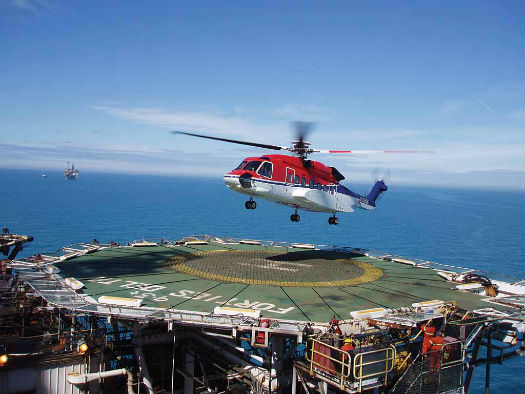
A CHC S-92 lands on a platform in the Forties Delta platform, one of five very large fixed platforms on the largest oil discovery in the U.K. sector of the North Sea. CHC Photo
Helicopter operations are concentrated in three geographic areas in the North Sea: southern, central/northern and Norwegian.
The southern sector of the North Sea is shallow water and mostly contains small gas installations, many of which are unmanned. Similar to the shallow areas of the Gulf of Mexico, its platforms are only visited for maintenance and inspections. In these instances, helicopters shuttle people from onshore, or from offshore manned platforms that serve as hubs. Health and safety requirements limit the number of people allowed on the unmanned installations, so the efficient solution is to utilize medium helicopters. The area is serviced from airports in Norwich, Humberside, and North Denes, (all in the U.K.); Den Helder, Netherlands; and Esbjerg, Denmark.
The central and northern North Sea has deeper water and harsh weather conditions characterized by cold temperatures, rain, high winds, and rough seas.
In this sector, the U.K.’s fields are primarily served from Aberdeen airport — the world’s busiest helicopter hub — which handles about 500,000 passengers each year. The country’s northernmost floating and fixed platforms are supported from Scatsta and Sumburgh airports in the Shetland Islands.
Serving the oil and gas fields in Norwegian waters are helicopters based at Stavanger, Florø and Bergen. (Further up the coast, helicopters also support offshore activity in the Norwegian Sea and Barents Sea.)
CHC and Bristow have similarly-sized helicopter fleets in the North Sea, with CHC having a larger share of the robust Norwegian market (and a strong presence in the Netherlands), while Bristow has a larger share of the U.K. offshore transport market it initiated 50 years ago.

Bel Air Aviation A/S of Denmark is the second North Sea customer for the AgustaWestland AW189. Founded in the mid- 1990s, Bel Air started offshore service in 2009, flying AW139s to oil platforms on the Danish continental shelf. AgustaWestland Photo
A founding member
On a stormy day on Feb. 17, 1965, a Bristow Westland Whirlwind Series 3 took off from Sunderland airport to the drilling rig Mister Cap located at Dogger Bank. This was the first flight to carry passengers to a North Sea drilling rig from a U.K. base — and the beginning of a new era in helicopter transportation.
Bristow Helicopters won 11 of the first 12 offshore helicopter support contracts in the U.K., and has been a major presence in the North Sea ever since.
The company’s ownership changed in 1996, when Offshore Logistics of the U.S. bought a 49 percent share of Bristow Helicopters. The parent company rebranded itself the Bristow Group in 2006, taking the name of its internationally-recognized U.K. subsidiary.
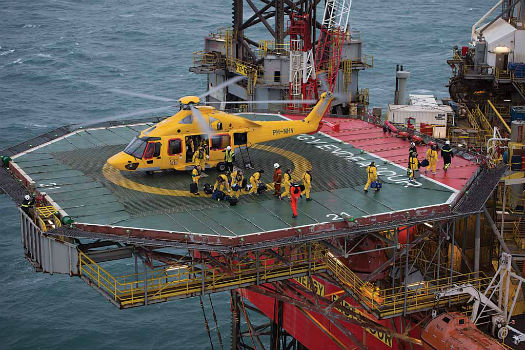
An NHV EC175 on the helideck of Energy Endeavour jackup rig, drilling for Wintershall off the coast of the Netherlands. NHV Group Photo
Today, the Bristow Group has 76 helicopters based in Europe, including 68 large helicopters and eight medium helicopters, which operate from five offshore bases in the U.K. and four in Norway.
In Aberdeen alone, Bristow flies about 650 to 700 flights per month — or 30 to 35 flights a day, Monday to Friday — that service the central North Sea, West of Shetland, and East Shetland Basin regions, transporting between 200,000 and 250,000 passengers each year.
Among Bristow’s contracts is a service to transport workers to platforms located off the Shetland Islands via fixed-wing Eastern Airways 50-seat Saab 2000s (the Bristow Group owns 60 percent of Eastern Airways). The aircraft fly from Aberdeen to Scatsta airport, where six Bristow S-92s then connect the workers to their offshore platforms. Bristow has held this contract (with the Integrated Aviation Consortium, which represents seven oil companies) since 1996, and it manages the entire operation. The service requires 90 helicopter flights and 120 fixed-wing flights each week, and transports 2,500 passengers weekly.
Bristow’s Norwich base is home to two new AW189s serving installations in the southern North Sea for two customers, and four more AW189s are due to be delivered in the coming months for oil-and-gas operations and SAR.
In Norway, Bristow has recently started a new contract that sees a SAR EC225 based offshore on the Ekofisk platform.
In June 2013, Bristow began SAR services with four S-92s from Sumburgh and Stornoway on behalf of the U.K. Maritime & Coastguard Agency, marking the start of the U.K. Gap SAR contract for Northern Scotland. The company is set to begin providing public sector SAR services for all the U.K. this year, using 11 S-92s and 11 AW189s from 10 bases.

DanCopter AS, a subsidiary of Blueway Group (and now NHV Group), took delivery of four EC225s in 2012-2013 for offshore use off Denmark and Norway. DanCopter also flies Airbus Helicopters EC155 B1s offshore in the U.K. and the Netherlands. Anthony Pecchi Photo
A Canadian Influence
CHC Group was formed in 1987 when three of Canada’s largest offshore and IFR helicopter operators (Sealand, Okanagan Helicopters, Toronto) were merged by Newfoundland businessman Craig Dobbin and investors. The group expanded into the North Sea with its purchase of British International Helicopters in 1994, followed by Norway’s Helikopter Services Group in 1999 (which included Bond Helicopters and Maersk Helicopters) and the Dutch Schreiner Aviation Group in 2004 (which included KLM Era Helicopters assets).
“The acquisitions gave us unparalleled knowledge of the North Sea market, and a strong relationship with major oil companies such as Statoil — who we fly for in Norway and globally,” said Peter Bartolotta, chief operating officer and president of CHC Helicopter Services.
In early 2015, CHC had 82 helicopters based in Europe, including 33 aircraft operating from four oil-and-gas bases in the U.K., 11 from one base in the Netherlands, and 30 from four Norwegian bases. It also has three SAR AW139s in the UK, and five SAR S-92s in Ireland. CHC subsidiary Heli-One also has a complete “nose-to-tail” 160,000-square-foot helicopter maintenance, repair, and overhaul facility in Stavanger, Norway, which supports the North Sea fleet and does third party work.
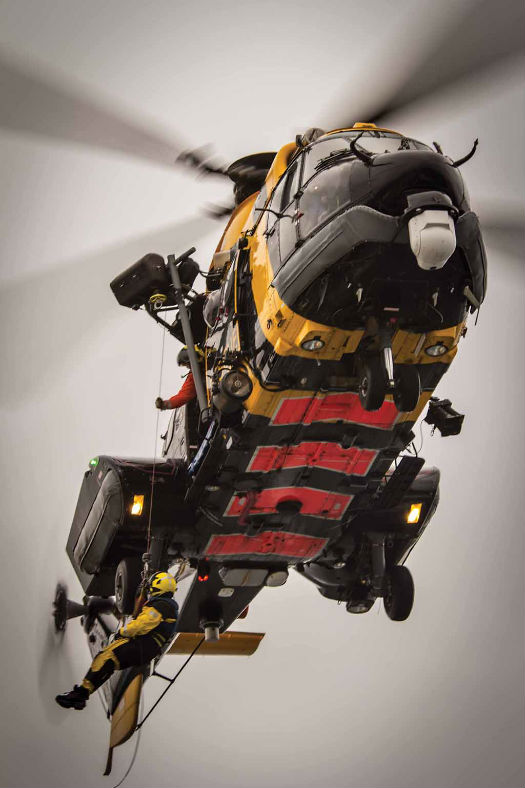
Bond Offshore Helicopters’ two BP Jigsaw SAR AS332 L2 Super Pumas are based at Sumburgh and BP’s Miller platform in the central North Sea. Jigsaw operations were launched in March 2006. Bond Photo
CHC flies an average of 1,400 flights and 2,500 flight hours a month off Norway, and 1,400 flights and 3,500 flight hours from the U.K. and the Netherlands — with one half of this total coming from Aberdeen.
In Norway, the company also has four Super Pumas based offshore: three are “all-weather” SAR helicopters (one AS332 L and two EC225s) based at the Heidrun, Oseberg and Statfjord production platforms, and one crew shuttle AS332 L is based at BP’s Valhall oil field — Norway’s third largest. The offshore bases each have a large hangar and maintenance facility, as well as an aircraft elevator to rapidly transfer the helicopter to the helideck from the hangar. The SAR helicopters are crewed 24/7 and fly with pilots, a rescue technician and a medical attendant.
Dr. Øivind Solberg, general manager of CHC’s eastern North Sea business unit, said the company has been very active promoting safety management systems and implementing new technology for more efficient and safer operations.
“The backbone of any robust safety management system [SMS] is good reporting from the sharp end of the organization that collects data on every occurrence — big and small,” said Solberg, who took time off from piloting offshore helicopters to complete a PhD in safety and risk management. “Once you have a system to collect the data, you can run a statistical analysis to get a clear and accurate overview of potential risks — and identify actions that will help you mitigate these risks. We have such a system.”
CHC is also pushing to introduce real-time flight data monitoring across its fleet to enhance helicopter safety and reliability — and envisions streaming more comprehensive maintenance reliability data directly to the original equipment manufacturers.
A familiar presence
Bond Offshore Helicopters was formed in 2004, but the founding Bond family began flying offshore back in 1972, when David Bond’s Management Aviation began servicing remote U.K. lighthouses with an MBB Bo.105. In 1978, as North Scottish Helicopters, the company started serving oil platforms in the North Sea with Sikorsky S-61Ns.
The business was rebranded as Bond Helicopters in 1984, and was the U.K’s third largest offshore operator when it merged with Helikopter Service of Norway in 1996 (which subsequently sold Bond Air Services — the light helicopter unit flying air ambulance, police support and charter services — back to David Bond’s sons, Stephen and Peter Bond, in 1999).

Bond Offshore Helicopters flies S-92s to platforms in the central and northern North Sea from Aberdeen, Scotland. In 2013, the company carried 160,000 men and women to their work offshore, flying more than 22,000 hours. Bond Photo
Bond reentered the offshore business in 2002 as Bond Offshore Helicopters with an initial fleet of five AS332 L2 Super Pumas, after winning a 10-year, $400-million contract from BP Exploration. BP was keen to create a third offshore operator in the U.K., and also awarded Bond a long-term contract to operate two AS332 L2 Super Pumas as part of the Jigsaw SAR program, with the aircraft based at Sumburgh and BP’s Miller platform in the central North Sea. The aircraft are equipped with infrared cameras, dual hoist systems, night vision systems, loudhailers, searchlights and satellite communications.
In 2011, another ownership change brought the Bond Aviation Group under the umbrella of what was to become the Avincis Group. The following year, Avincis purchased Norsk Helikopterservice (NHS) — an offshore operator based in Sola, Norway — bringing the new parent company’s overall fleet to about 350 aircraft.
In February 2013, NHS took delivery of its first two S-92s, and the close ties it has with its sister company saw the two helicopters immediately flown to Aberdeen, where they were wet-leased to Bond to serve customers impacted by the EC225 grounding.
The latest corporate restructuring took place in March 2014, when Babcock International (a leading engineering support services company and major defense contractor) bought Avincis Group for £920 million (about US$1.39 billion).
Today, Bond Offshore Helicopters and sister company NHS fly the third largest fleet of heavy helicopters in the North Sea, with 23 aircraft operating from four U.K. locations. Bond is also the only helicopter company flying to gas fields off the west coast of England in the Irish Sea, with two AS365 N3s based at Blackpool airport.
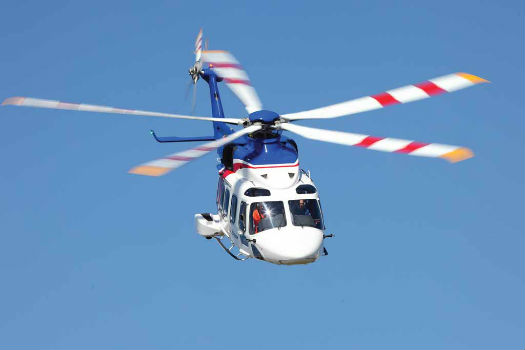
Bristow’s AW189s made their first revenue flight on July 21, 2014. Two AW189s based in Norwich fly for two customers in the southern North Sea. Bristow has also ordered 11 SAR AW189s to fly for the U.K. Maritime & Coastguard Agency. AgustaWestland Photo
A New Face
NHV was founded in 1997, and its first offshore base was in Rotterdam harbor, where it placed an AS365 N3 (it was, in fact, the launch customer for the type). The aircraft was used to fly marine pilots to large vessels entering or leaving Europe’s largest port. It then began flying to offshore platforms in the North Sea in 2005.
NHV has operated three SAR-configured AS365s from Den Helder airport and Pistoolhaven heliport in Rotterdam harbor since July 2011. One flies for the Dutch Coast Guard and the marine pilots in Rotterdam, and two for the NOGEPA (Dutch Oil and Gas Exploration and Production Association). The two contracts will be combined when NHV starts a five-year contract awarded by the Dutch government that starts in July 2015.
In mid-December 2014, NHV completed the first offshore revenue flight with an EC175.
“We believe the delivery of our EC175 is very well timed,” said NHV president and founder Eric Van Hal. “It is a very capable helicopter that can fly missions flown by larger [aircraft] for less cost.” He added that the company was looking at further opportunities to use it for oil-and-gas and SAR work.
Shortly after the momentous flight, NHV recorded another notable event in its history, completing its purchase of the Blueway Group of Norway. Blueway is a holding company for three offshore helicopter operators (DanCopter A/S, Blueway Offshore Norge AS, and Vertech Offshore), as well as Norway’s largest onshore operator (Airlift AS).
Today, the NHV Group flies offshore in the North Sea and in West Africa (from bases in Nigeria, the Ivory Coast and Ghana). It has 59 helicopters in total, with a solid order book of 16 helicopters (14 EC175s and two AW139s) for the next three years.
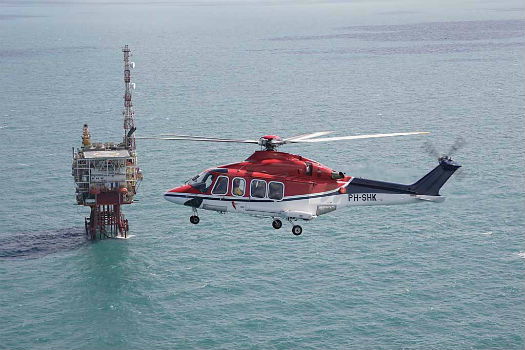
A CHC AW139 approaches an offshore gas rig in Dutch waters. The operator has 11 aircraft in the Netherlands serving the offshore market. CHC Photo
Raising the Bar
“The North Sea is widely regarded as having the highest standard of helicopter operations in the world,” said Mark Duncan, an independent industry expert and previously senior vice president of Bristow Group. He labeled it the “gold standard” for international helicopter operations with regards to its safety culture, work environment, and its long history of debuting new technology helicopters and systems.
“The highest standards dictate higher costs, and helicopter prices cannot be slashed during industry downturn cycles without endangering the viability of the businesses,” said Duncan. “Value is created [through] greater efficiency and utilization.”
The demands of operations in the region have helped drive innovation among those who fly there, but also among the helicopter manufacturers themselves.
“Ten to 15 years ago, you started to see the development of a new generation of helicopters designed specifically to meet North Sea performance and safety standards,” said Roberto Garavaglia, senior VP of strategy and business development at AgustaWestland. “You started to see helicopters with integrated digital avionics systems, more powerful engines for better single-engine performance, new gearboxes certified to run longer without oil, larger cargo compartments, bigger cabins and seats to accommodate passengers wearing immersion suits, and larger push-out window emergency exits.”
The first wave of new generation aircraft debuted in the North Sea in 2005 when the EC225, S-92 and AW139 were delivered to launch customers. The second wave began in July 2014 when the AW189 made its first revenue flight from Norwich.
“The AW189 builds on the success of the AW139, but was more specifically designed for offshore missions,” says Garavaglia. “About 35 percent of the AW139s delivered are in offshore service, and with the AW189 we expect this to be closer to 80 percent, since its capacity and range are more specialized.”

Bell Helicopter will fly the prototype Bell 525 Relentless in 2015. The company expects that about 60 percent of 525 sales will be for offshore use. Bell Helicopter Photo
The wave of new aircraft continued in December 2014, when an EC175 left Den Helder, Netherlands, for the type’s first revenue flight.
“The EC175 introduces a new combination of performance, cabin size and operating cost to the super medium helicopter market,” said Christopher Grainger, oil and gas customer relations, Airbus Helicopters. “It is designed to carry 16 passengers 140 nautical miles offshore, which puts about 90 percent of the platforms in the North Sea within the range capabilities.”
Eventually competing with the AW189 and the EC175 will be Bell Helicopter’s 525 Relentless. Chuck Evans, Bell’s director of marketing, said the company expects about 60 to 65 percent of the aircraft’s sales will be in the offshore sector.
“Safety was the number one design objective, but the helicopter is also fast, smooth and economical,” said Evans. Bell has also given the 525 extra-long legs so it can fly to certain offshore platforms that have, until now, been the exclusive domain of heavy aircraft.
“The 525 is designed to fly eight passengers 250 nautical miles offshore and back, with 20 percent fuel reserves — at ISA 20 C PC2e [category A, performance class two, enhanced] — for a lower cost than a heavy helicopter,” added Mike Suldo, Bell’s key segment specialist. “The 525 has also been designed with a low center of gravity and to float in sea state six conditions.”
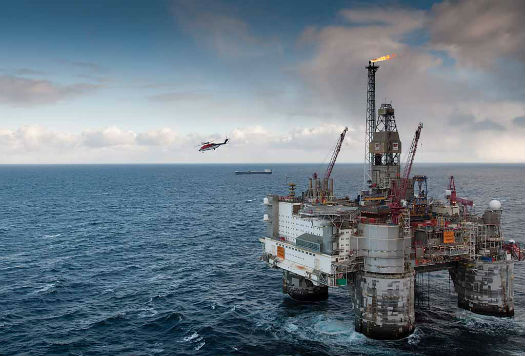
A CHC S-92 departs the Heidrun platform 118 miles (190 km) offshore in the Norwegian Sea. The Heidrun platform is home base for a CHC SAR AS332 L contracted by Statoil. Øyvind Hagen Photo
The EC175 weighs in at 7.5 tonnes, the AW189 at 8.3/8.5 tonnes and the Bell 525 at 8.7 tonnes.
Interestingly, AgustaWestland is also starting to pitch the new AW609 TiltRotor for certain oil-and-gas support missions and in a SAR role. (The company said it is developing a larger design for a mass transport role.)
“The TiltRotor has three advantages in the offshore market,” says Garavaglia. “Range, speed and since it is a pressurized aircraft, it can fly over bad weather at altitudes up to 25,000 feet — the same as an ATR turboprop. A tilt rotor is also very efficient from a fuel burn perspective, because of its higher aerodynamic efficiency and the possibility to fly at high altitudes.”
Operations have certainly come a long way in the last half century, since the first pioneering helicopter crews ventured out in miserable weather conditions to North Sea drilling platforms. With perseverance, they created an industry — one that would become the largest offshore market in the world — and while North Sea oil and gas production may be in decline, the need for helicopters to perform vital crew change activities continues unabated. And, with the growth of civilian SAR set to continue, North Sea helicopter operators seem to have a promising future to match their storied past.





